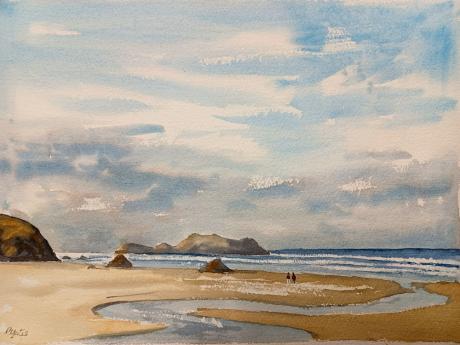" P Yates" and inscribed on the reverse
Bandon Beach on the Oregon Coast is known for its famous rock formations jutting out of the ocean and its magical sunsets. There are miles and miles of beaches to enjoy, each sprinkled with its own dramatic boulders. Bandon has some of the most scenic beaches on the Oregon Coast. The views and rocky landmarks here will make you question how nature could have possibly formed them.
One of the most defining features of this stretch of coast is its many sea stacks, which are remnants of an ancient marine terrace. They make the perfect home for a great variety of sea creatures, which makes tide pooling one of the most popular activities here.Some rocks are more notable than others. Face Rock is one of the more well-known landmarks and is the subject of a local legend, accompanied by the sea stacks Komax and the Cat and Kittens.Elephant Rock got its name, unsurprisingly, from the fact that it looks like the head of a partially submerged elephant’s head. Wizards Hat is of course shaped like a huge wizard’s hat, jutting dramatically out of the water. These are just a few of the sea stacks that span the coast, making for some incredible views. Photographers and artists come from all over to capture these dramatic rock formations, especially at sunset when they are silhouetted with the light behind them.
Collectively they are managed as part of the Oregon Islands National Wildlife Refuge, home to thousands of nesting sea birds. Bring along your binoculars and see what species you can spot. You can see some of the rocks at their best from the various viewpoints along the coast. Face Rock State Scenic Viewpoint offers sights that will take your breath away, while just a simple walk along the shore will allow you a closer look.
The land was acquired between 1954 and 1970 by purchase from various owners and a gift from Coos County. The city of Bandon was named for Bandon, Ireland, by George Bennett, who settled in the area in 1873.
Before 1850, the Coquille Indians lived in the area. Then in 1851, gold was discovered at nearby Whiskey Run Beach by French Canadian trappers, though the gold rush did not have much of an impact on the area. In 1852, Henry Baldwin, from County Cork, Ireland, was shipwrecked on the Coos Bay bar and walked into this area. The first permanent European settlers came in 1853 and established the present town site. In 1856, the first conflicts with Indigenous Americans in the area arose and those were sent to the Siletz Reservation. In 1859, the boat Twin Sisters sailed into the Coquille River and opened the outlet for all inland produce and resources.
Bandon was founded by the Irish peer George Bennett in 1873. George Bennett, his sons Joseph and George, and George Sealey came from Bandon, Ireland. The following year the town's previous name of Averille was changed to Bandon after the town of the same name in Ireland. The next year, Joseph Williams and his three sons arrived, also from Bandon, Ireland. In 1877, the post office was established. In 1880, cheese making began. That same year, Congress appropriated money to build the jetty. In 1883, the first sawmill, school house, and Catholic church were built. In 1884, the U.S. Army Corps of Engineers began construction on the jetty.
George Bennett also introduced gorse (Ulex europaeus) into the local area, which in the following decades went wild and became a nuisance in both the town and in the neighboring countryside. Gorse, a spiny plant, grows so thickly a person cannot walk through it. It is also a very oily plant, which easily catches fire.
Cranberries have been grown in Bandon since 1885, when Charles McFarlin planted vines he brought from Massachusetts. McFarlin had originally come to pan for gold in California. He did not make his fortune, or even a living, so he turned to what he knew best. He brought vines from Cape Cod and planted them in the state's first cranberry bog near Hauser. This bog produced cranberries for eight decades. His variety adapted to growing conditions on the west coast. The variety was named McFarlin in his honor and was the principal variety grown on the west coast until overtaken by the Stevens variety. Bandon is also the location of the first cranberry bogs to be wet harvested, which is done by building dikes around the bogs then flooding them.
In 2010, Bandon was named one of the "Coolest Small Towns in America" by BudgetTravel.

